Finance Mini Project: Analysis of Hedging Strategies and JP Morgan
VerifiedAdded on 2020/10/22
|7
|1679
|338
Project
AI Summary
This finance mini-project delves into the concept of hedging as a risk management strategy used to mitigate potential financial losses stemming from market fluctuations. The project begins by defining hedging, highlighting its role in protecting investments against adverse price movements in commodities, currencies, and securities. It then presents a discussion on two arguments against and two arguments for hedging, providing a balanced perspective on its application. The project further examines the hedging practices of J.P. Morgan, an American multinational investment bank and financial services company, specifically focusing on its approach to foreign exchange risk management. The project analyzes the hedging tools employed by J.P. Morgan, including forwards, plain vanilla purchased options, zero premium collars, and zero premium participating forwards. The project agrees with some of JP Morgan's approach and suggests improvements, particularly recommending the use of options as a hedging tool, and discusses the advantages of options over forward contracts. In conclusion, the project emphasizes the importance of hedging in protecting against unfavorable market conditions and highlights the benefits of using options as a flexible risk management tool. The references section includes books, journals, and online resources used in the research.

FINANCE MINI PROJECT
Paraphrase This Document
Need a fresh take? Get an instant paraphrase of this document with our AI Paraphraser
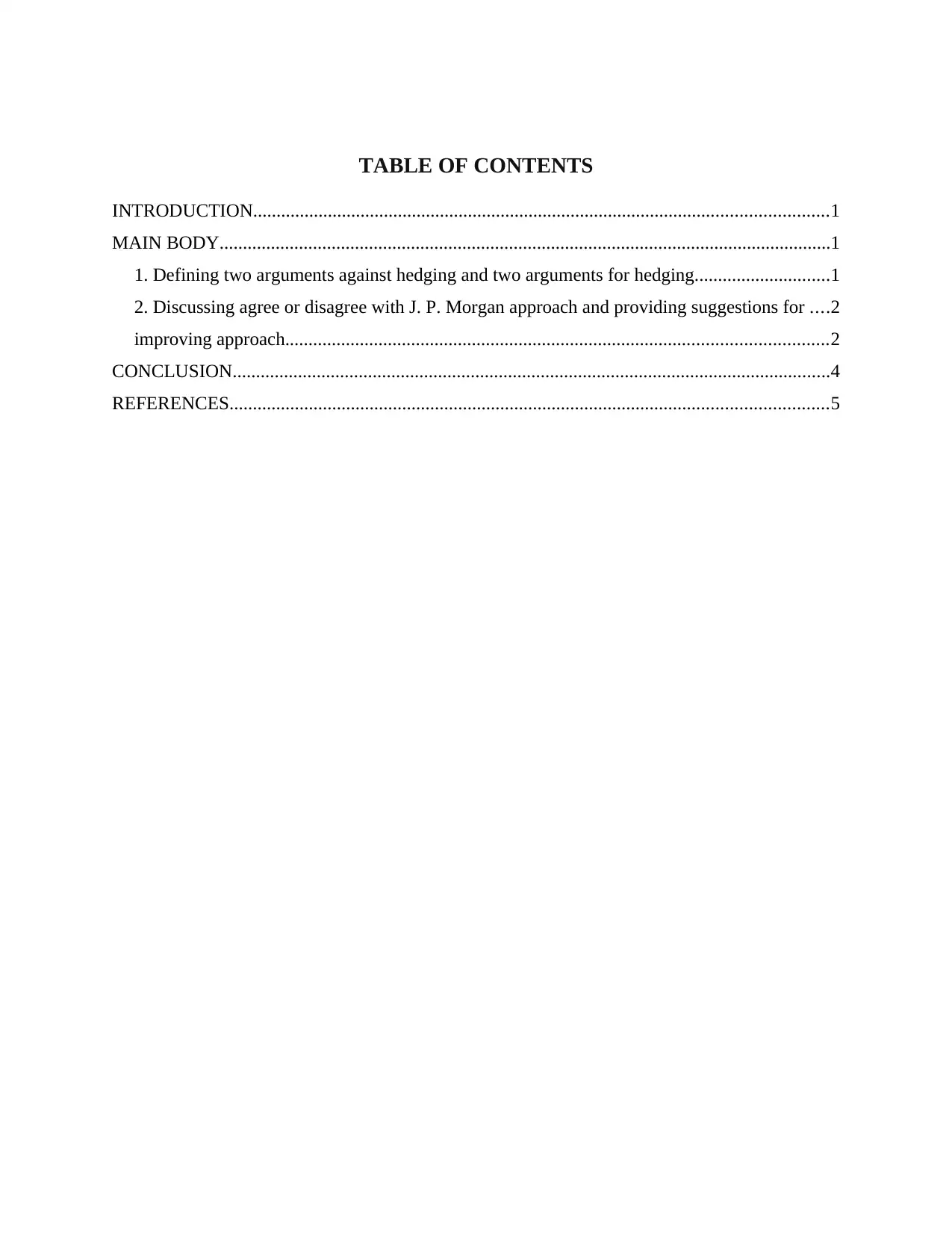
TABLE OF CONTENTS
INTRODUCTION...........................................................................................................................1
MAIN BODY...................................................................................................................................1
1. Defining two arguments against hedging and two arguments for hedging.............................1
2. Discussing agree or disagree with J. P. Morgan approach and providing suggestions for ....2
improving approach....................................................................................................................2
CONCLUSION................................................................................................................................4
REFERENCES................................................................................................................................5
INTRODUCTION...........................................................................................................................1
MAIN BODY...................................................................................................................................1
1. Defining two arguments against hedging and two arguments for hedging.............................1
2. Discussing agree or disagree with J. P. Morgan approach and providing suggestions for ....2
improving approach....................................................................................................................2
CONCLUSION................................................................................................................................4
REFERENCES................................................................................................................................5
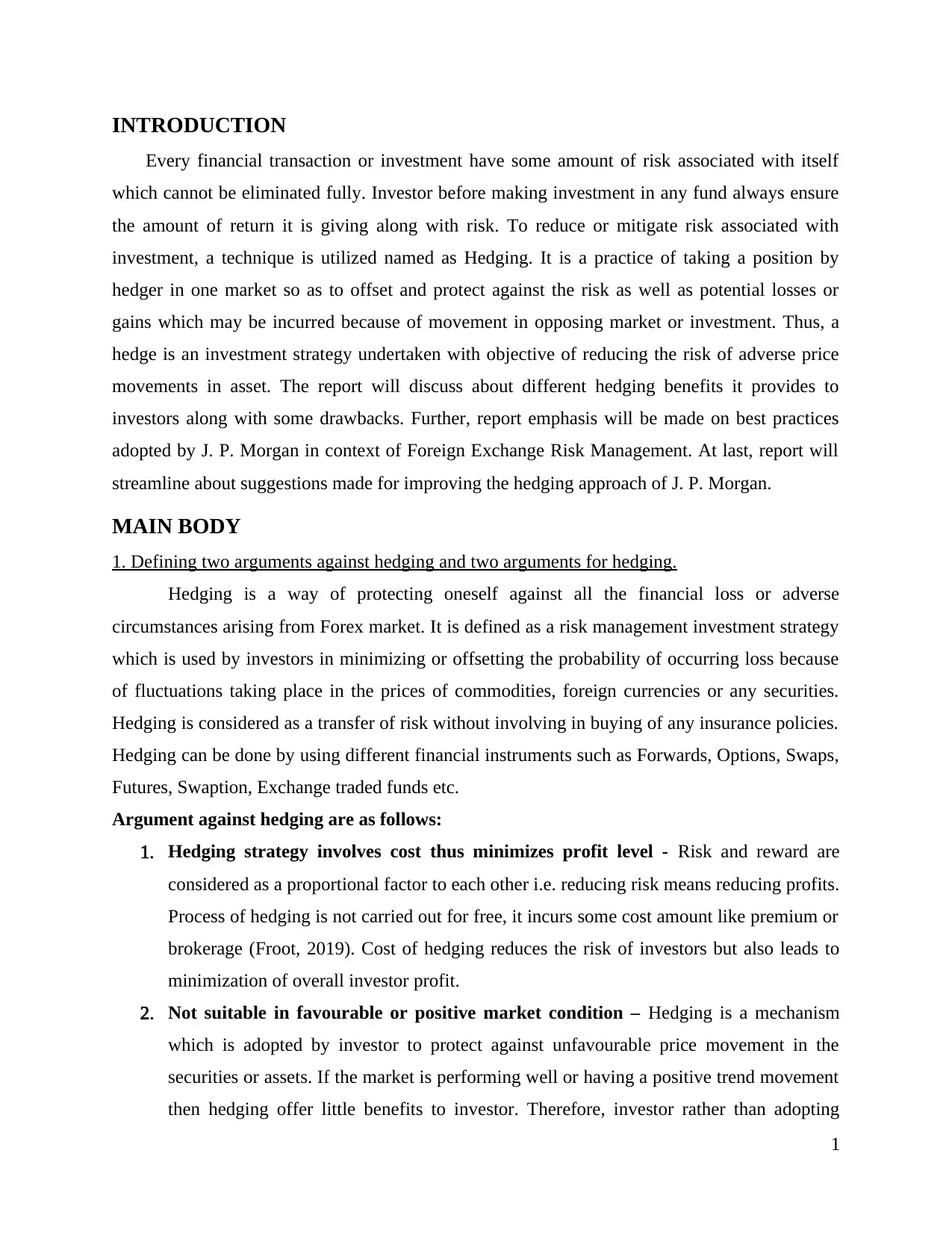
INTRODUCTION
Every financial transaction or investment have some amount of risk associated with itself
which cannot be eliminated fully. Investor before making investment in any fund always ensure
the amount of return it is giving along with risk. To reduce or mitigate risk associated with
investment, a technique is utilized named as Hedging. It is a practice of taking a position by
hedger in one market so as to offset and protect against the risk as well as potential losses or
gains which may be incurred because of movement in opposing market or investment. Thus, a
hedge is an investment strategy undertaken with objective of reducing the risk of adverse price
movements in asset. The report will discuss about different hedging benefits it provides to
investors along with some drawbacks. Further, report emphasis will be made on best practices
adopted by J. P. Morgan in context of Foreign Exchange Risk Management. At last, report will
streamline about suggestions made for improving the hedging approach of J. P. Morgan.
MAIN BODY
1. Defining two arguments against hedging and two arguments for hedging.
Hedging is a way of protecting oneself against all the financial loss or adverse
circumstances arising from Forex market. It is defined as a risk management investment strategy
which is used by investors in minimizing or offsetting the probability of occurring loss because
of fluctuations taking place in the prices of commodities, foreign currencies or any securities.
Hedging is considered as a transfer of risk without involving in buying of any insurance policies.
Hedging can be done by using different financial instruments such as Forwards, Options, Swaps,
Futures, Swaption, Exchange traded funds etc.
Argument against hedging are as follows:
1. Hedging strategy involves cost thus minimizes profit level - Risk and reward are
considered as a proportional factor to each other i.e. reducing risk means reducing profits.
Process of hedging is not carried out for free, it incurs some cost amount like premium or
brokerage (Froot, 2019). Cost of hedging reduces the risk of investors but also leads to
minimization of overall investor profit.
2. Not suitable in favourable or positive market condition – Hedging is a mechanism
which is adopted by investor to protect against unfavourable price movement in the
securities or assets. If the market is performing well or having a positive trend movement
then hedging offer little benefits to investor. Therefore, investor rather than adopting
1
Every financial transaction or investment have some amount of risk associated with itself
which cannot be eliminated fully. Investor before making investment in any fund always ensure
the amount of return it is giving along with risk. To reduce or mitigate risk associated with
investment, a technique is utilized named as Hedging. It is a practice of taking a position by
hedger in one market so as to offset and protect against the risk as well as potential losses or
gains which may be incurred because of movement in opposing market or investment. Thus, a
hedge is an investment strategy undertaken with objective of reducing the risk of adverse price
movements in asset. The report will discuss about different hedging benefits it provides to
investors along with some drawbacks. Further, report emphasis will be made on best practices
adopted by J. P. Morgan in context of Foreign Exchange Risk Management. At last, report will
streamline about suggestions made for improving the hedging approach of J. P. Morgan.
MAIN BODY
1. Defining two arguments against hedging and two arguments for hedging.
Hedging is a way of protecting oneself against all the financial loss or adverse
circumstances arising from Forex market. It is defined as a risk management investment strategy
which is used by investors in minimizing or offsetting the probability of occurring loss because
of fluctuations taking place in the prices of commodities, foreign currencies or any securities.
Hedging is considered as a transfer of risk without involving in buying of any insurance policies.
Hedging can be done by using different financial instruments such as Forwards, Options, Swaps,
Futures, Swaption, Exchange traded funds etc.
Argument against hedging are as follows:
1. Hedging strategy involves cost thus minimizes profit level - Risk and reward are
considered as a proportional factor to each other i.e. reducing risk means reducing profits.
Process of hedging is not carried out for free, it incurs some cost amount like premium or
brokerage (Froot, 2019). Cost of hedging reduces the risk of investors but also leads to
minimization of overall investor profit.
2. Not suitable in favourable or positive market condition – Hedging is a mechanism
which is adopted by investor to protect against unfavourable price movement in the
securities or assets. If the market is performing well or having a positive trend movement
then hedging offer little benefits to investor. Therefore, investor rather than adopting
1
⊘ This is a preview!⊘
Do you want full access?
Subscribe today to unlock all pages.

Trusted by 1+ million students worldwide
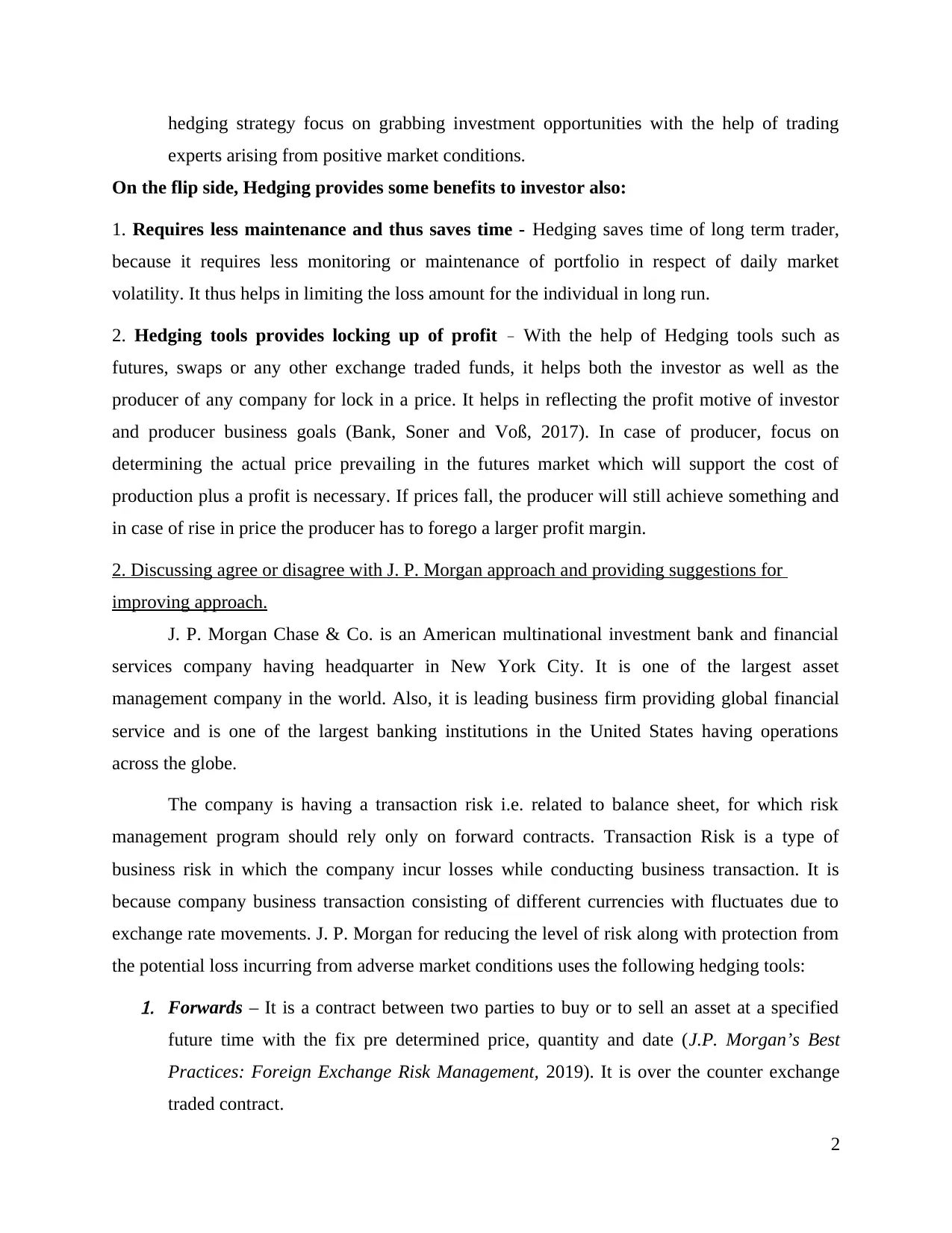
hedging strategy focus on grabbing investment opportunities with the help of trading
experts arising from positive market conditions.
On the flip side, Hedging provides some benefits to investor also:
1. Requires less maintenance and thus saves time - Hedging saves time of long term trader,
because it requires less monitoring or maintenance of portfolio in respect of daily market
volatility. It thus helps in limiting the loss amount for the individual in long run.
2. Hedging tools provides locking up of profit – With the help of Hedging tools such as
futures, swaps or any other exchange traded funds, it helps both the investor as well as the
producer of any company for lock in a price. It helps in reflecting the profit motive of investor
and producer business goals (Bank, Soner and Voß, 2017). In case of producer, focus on
determining the actual price prevailing in the futures market which will support the cost of
production plus a profit is necessary. If prices fall, the producer will still achieve something and
in case of rise in price the producer has to forego a larger profit margin.
2. Discussing agree or disagree with J. P. Morgan approach and providing suggestions for
improving approach.
J. P. Morgan Chase & Co. is an American multinational investment bank and financial
services company having headquarter in New York City. It is one of the largest asset
management company in the world. Also, it is leading business firm providing global financial
service and is one of the largest banking institutions in the United States having operations
across the globe.
The company is having a transaction risk i.e. related to balance sheet, for which risk
management program should rely only on forward contracts. Transaction Risk is a type of
business risk in which the company incur losses while conducting business transaction. It is
because company business transaction consisting of different currencies with fluctuates due to
exchange rate movements. J. P. Morgan for reducing the level of risk along with protection from
the potential loss incurring from adverse market conditions uses the following hedging tools:1. Forwards – It is a contract between two parties to buy or to sell an asset at a specified
future time with the fix pre determined price, quantity and date (J.P. Morgan’s Best
Practices: Foreign Exchange Risk Management, 2019). It is over the counter exchange
traded contract.
2
experts arising from positive market conditions.
On the flip side, Hedging provides some benefits to investor also:
1. Requires less maintenance and thus saves time - Hedging saves time of long term trader,
because it requires less monitoring or maintenance of portfolio in respect of daily market
volatility. It thus helps in limiting the loss amount for the individual in long run.
2. Hedging tools provides locking up of profit – With the help of Hedging tools such as
futures, swaps or any other exchange traded funds, it helps both the investor as well as the
producer of any company for lock in a price. It helps in reflecting the profit motive of investor
and producer business goals (Bank, Soner and Voß, 2017). In case of producer, focus on
determining the actual price prevailing in the futures market which will support the cost of
production plus a profit is necessary. If prices fall, the producer will still achieve something and
in case of rise in price the producer has to forego a larger profit margin.
2. Discussing agree or disagree with J. P. Morgan approach and providing suggestions for
improving approach.
J. P. Morgan Chase & Co. is an American multinational investment bank and financial
services company having headquarter in New York City. It is one of the largest asset
management company in the world. Also, it is leading business firm providing global financial
service and is one of the largest banking institutions in the United States having operations
across the globe.
The company is having a transaction risk i.e. related to balance sheet, for which risk
management program should rely only on forward contracts. Transaction Risk is a type of
business risk in which the company incur losses while conducting business transaction. It is
because company business transaction consisting of different currencies with fluctuates due to
exchange rate movements. J. P. Morgan for reducing the level of risk along with protection from
the potential loss incurring from adverse market conditions uses the following hedging tools:1. Forwards – It is a contract between two parties to buy or to sell an asset at a specified
future time with the fix pre determined price, quantity and date (J.P. Morgan’s Best
Practices: Foreign Exchange Risk Management, 2019). It is over the counter exchange
traded contract.
2
Paraphrase This Document
Need a fresh take? Get an instant paraphrase of this document with our AI Paraphraser
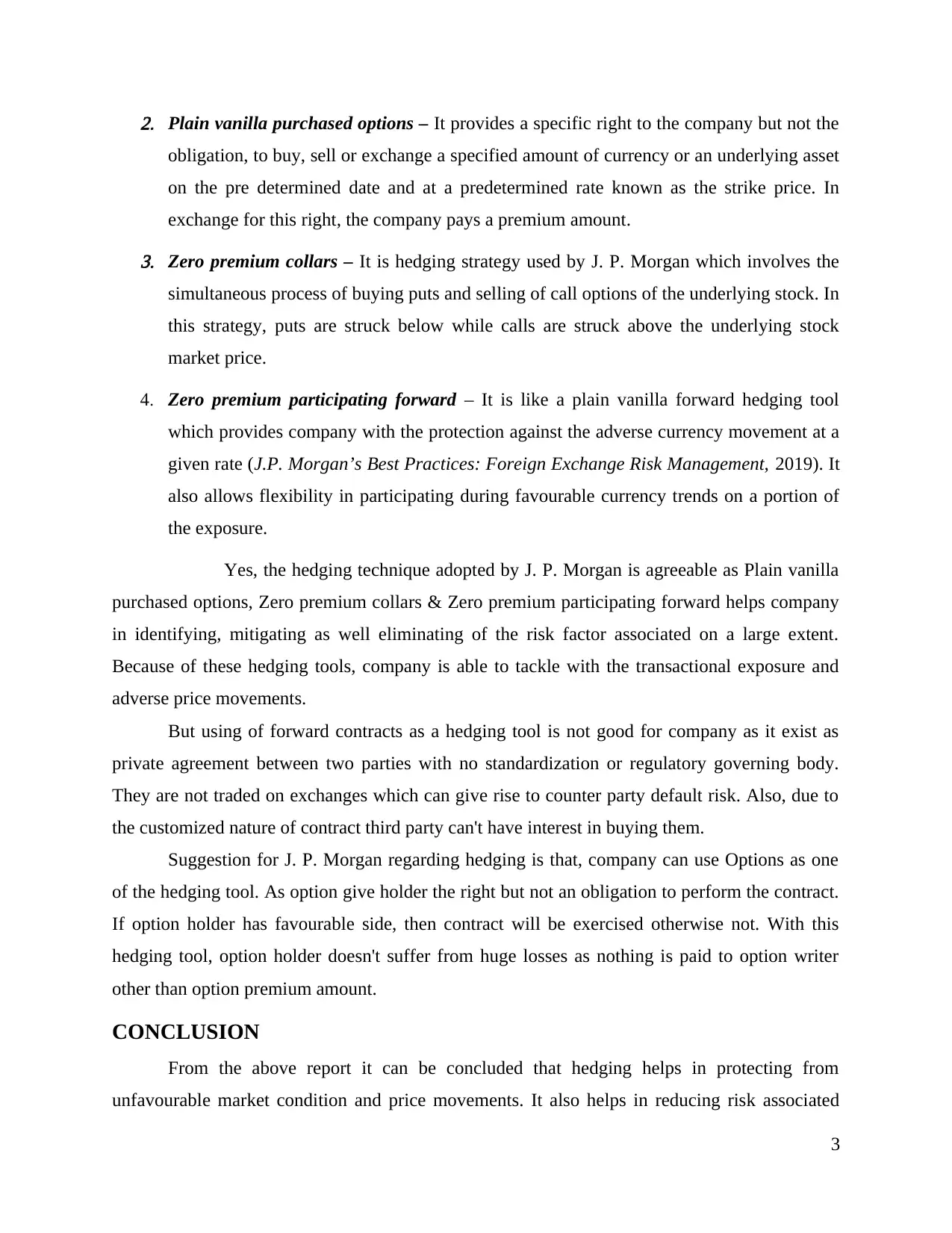
2. Plain vanilla purchased options – It provides a specific right to the company but not the
obligation, to buy, sell or exchange a specified amount of currency or an underlying asset
on the pre determined date and at a predetermined rate known as the strike price. In
exchange for this right, the company pays a premium amount.3. Zero premium collars – It is hedging strategy used by J. P. Morgan which involves the
simultaneous process of buying puts and selling of call options of the underlying stock. In
this strategy, puts are struck below while calls are struck above the underlying stock
market price.
4. Zero premium participating forward – It is like a plain vanilla forward hedging tool
which provides company with the protection against the adverse currency movement at a
given rate (J.P. Morgan’s Best Practices: Foreign Exchange Risk Management, 2019). It
also allows flexibility in participating during favourable currency trends on a portion of
the exposure.
Yes, the hedging technique adopted by J. P. Morgan is agreeable as Plain vanilla
purchased options, Zero premium collars & Zero premium participating forward helps company
in identifying, mitigating as well eliminating of the risk factor associated on a large extent.
Because of these hedging tools, company is able to tackle with the transactional exposure and
adverse price movements.
But using of forward contracts as a hedging tool is not good for company as it exist as
private agreement between two parties with no standardization or regulatory governing body.
They are not traded on exchanges which can give rise to counter party default risk. Also, due to
the customized nature of contract third party can't have interest in buying them.
Suggestion for J. P. Morgan regarding hedging is that, company can use Options as one
of the hedging tool. As option give holder the right but not an obligation to perform the contract.
If option holder has favourable side, then contract will be exercised otherwise not. With this
hedging tool, option holder doesn't suffer from huge losses as nothing is paid to option writer
other than option premium amount.
CONCLUSION
From the above report it can be concluded that hedging helps in protecting from
unfavourable market condition and price movements. It also helps in reducing risk associated
3
obligation, to buy, sell or exchange a specified amount of currency or an underlying asset
on the pre determined date and at a predetermined rate known as the strike price. In
exchange for this right, the company pays a premium amount.3. Zero premium collars – It is hedging strategy used by J. P. Morgan which involves the
simultaneous process of buying puts and selling of call options of the underlying stock. In
this strategy, puts are struck below while calls are struck above the underlying stock
market price.
4. Zero premium participating forward – It is like a plain vanilla forward hedging tool
which provides company with the protection against the adverse currency movement at a
given rate (J.P. Morgan’s Best Practices: Foreign Exchange Risk Management, 2019). It
also allows flexibility in participating during favourable currency trends on a portion of
the exposure.
Yes, the hedging technique adopted by J. P. Morgan is agreeable as Plain vanilla
purchased options, Zero premium collars & Zero premium participating forward helps company
in identifying, mitigating as well eliminating of the risk factor associated on a large extent.
Because of these hedging tools, company is able to tackle with the transactional exposure and
adverse price movements.
But using of forward contracts as a hedging tool is not good for company as it exist as
private agreement between two parties with no standardization or regulatory governing body.
They are not traded on exchanges which can give rise to counter party default risk. Also, due to
the customized nature of contract third party can't have interest in buying them.
Suggestion for J. P. Morgan regarding hedging is that, company can use Options as one
of the hedging tool. As option give holder the right but not an obligation to perform the contract.
If option holder has favourable side, then contract will be exercised otherwise not. With this
hedging tool, option holder doesn't suffer from huge losses as nothing is paid to option writer
other than option premium amount.
CONCLUSION
From the above report it can be concluded that hedging helps in protecting from
unfavourable market condition and price movements. It also helps in reducing risk associated
3
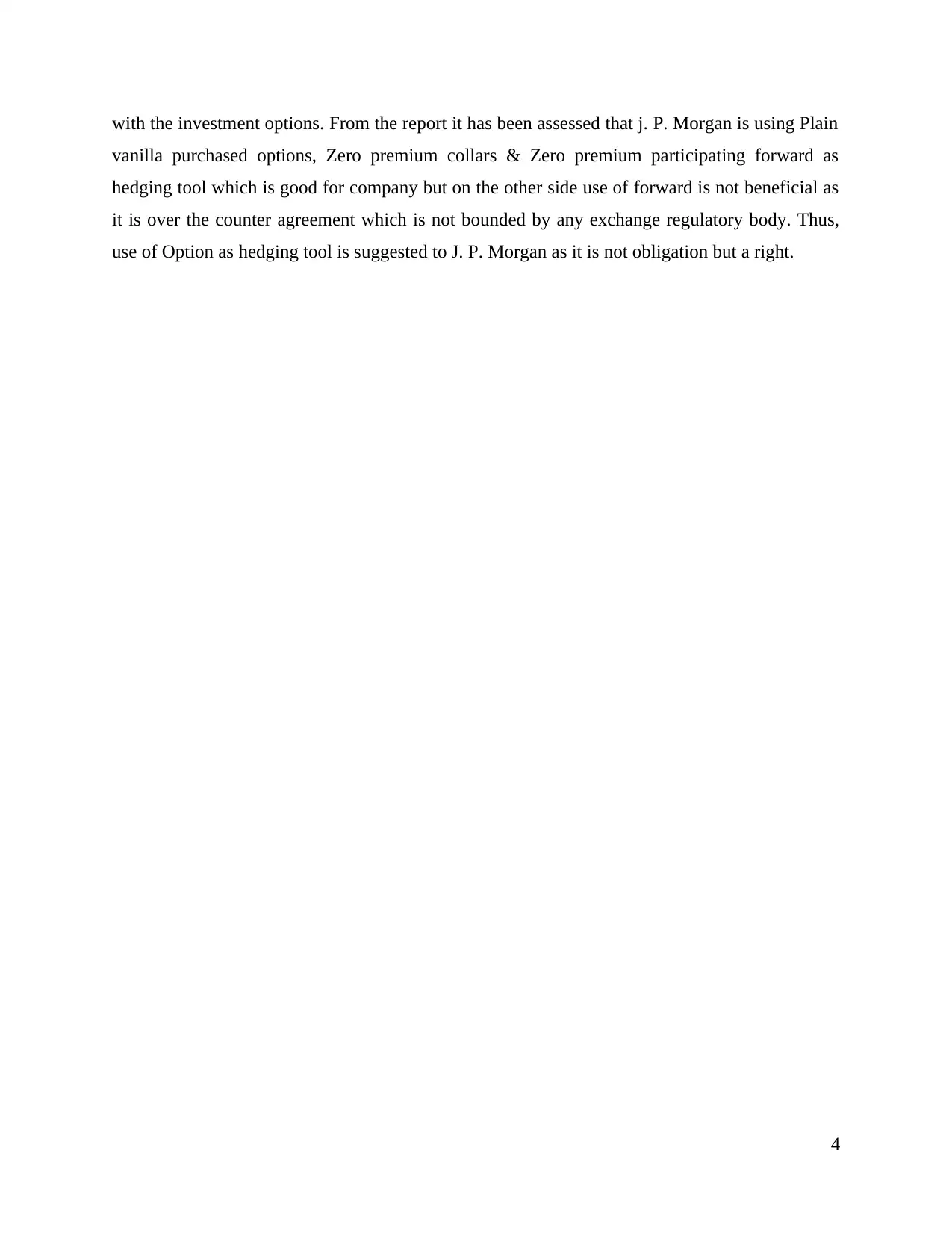
with the investment options. From the report it has been assessed that j. P. Morgan is using Plain
vanilla purchased options, Zero premium collars & Zero premium participating forward as
hedging tool which is good for company but on the other side use of forward is not beneficial as
it is over the counter agreement which is not bounded by any exchange regulatory body. Thus,
use of Option as hedging tool is suggested to J. P. Morgan as it is not obligation but a right.
4
vanilla purchased options, Zero premium collars & Zero premium participating forward as
hedging tool which is good for company but on the other side use of forward is not beneficial as
it is over the counter agreement which is not bounded by any exchange regulatory body. Thus,
use of Option as hedging tool is suggested to J. P. Morgan as it is not obligation but a right.
4
⊘ This is a preview!⊘
Do you want full access?
Subscribe today to unlock all pages.

Trusted by 1+ million students worldwide
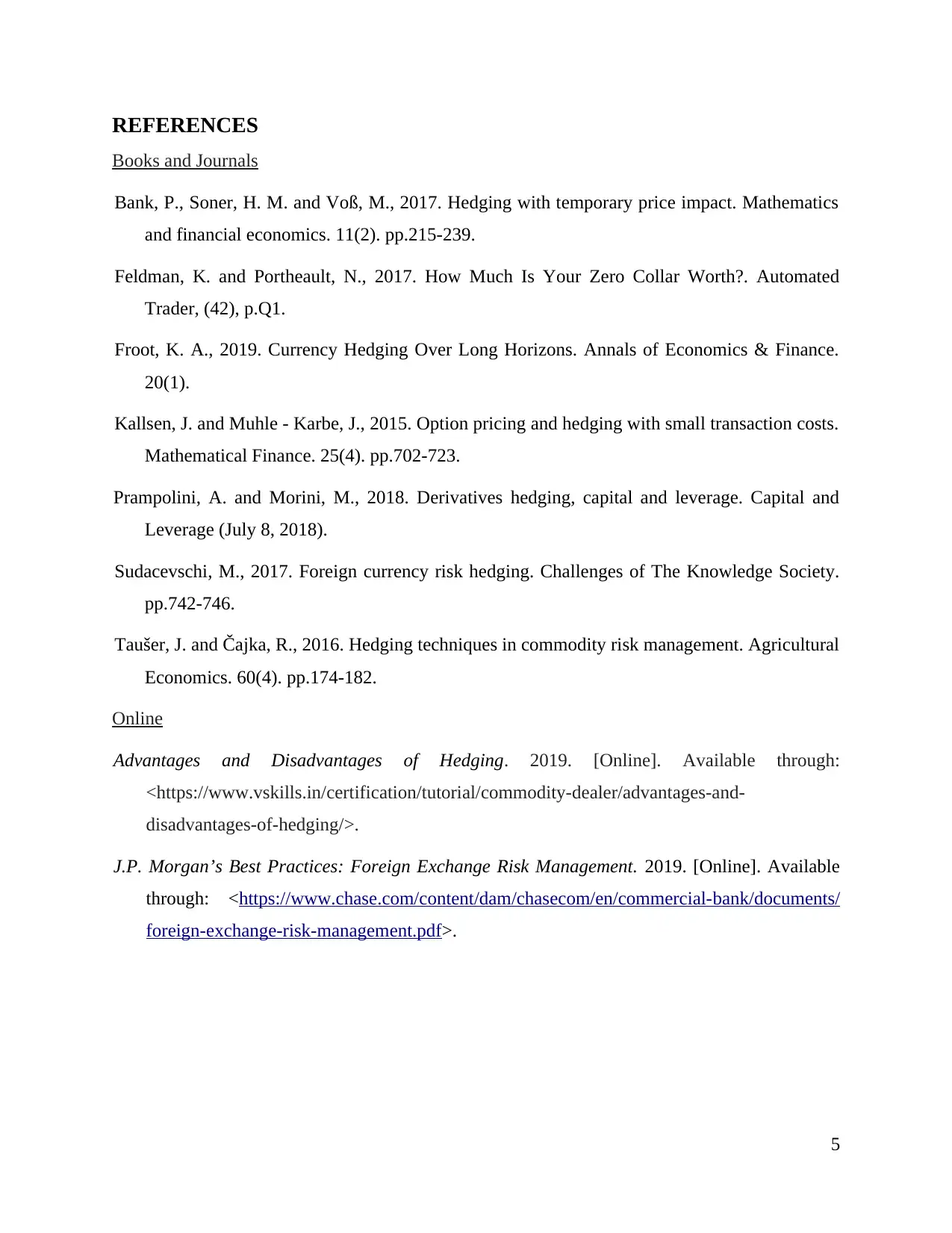
REFERENCES
Books and Journals
Bank, P., Soner, H. M. and Voß, M., 2017. Hedging with temporary price impact. Mathematics
and financial economics. 11(2). pp.215-239.
Feldman, K. and Portheault, N., 2017. How Much Is Your Zero Collar Worth?. Automated
Trader, (42), p.Q1.
Froot, K. A., 2019. Currency Hedging Over Long Horizons. Annals of Economics & Finance.
20(1).
Kallsen, J. and Muhle ‐ Karbe, J., 2015. Option pricing and hedging with small transaction costs.
Mathematical Finance. 25(4). pp.702-723.
Prampolini, A. and Morini, M., 2018. Derivatives hedging, capital and leverage. Capital and
Leverage (July 8, 2018).
Sudacevschi, M., 2017. Foreign currency risk hedging. Challenges of The Knowledge Society.
pp.742-746.
Taušer, J. and Čajka, R., 2016. Hedging techniques in commodity risk management. Agricultural
Economics. 60(4). pp.174-182.
Online
Advantages and Disadvantages of Hedging. 2019. [Online]. Available through:
<https://www.vskills.in/certification/tutorial/commodity-dealer/advantages-and-
disadvantages-of-hedging/>.
J.P. Morgan’s Best Practices: Foreign Exchange Risk Management. 2019. [Online]. Available
through: <https://www.chase.com/content/dam/chasecom/en/commercial-bank/documents/
foreign-exchange-risk-management.pdf>.
5
Books and Journals
Bank, P., Soner, H. M. and Voß, M., 2017. Hedging with temporary price impact. Mathematics
and financial economics. 11(2). pp.215-239.
Feldman, K. and Portheault, N., 2017. How Much Is Your Zero Collar Worth?. Automated
Trader, (42), p.Q1.
Froot, K. A., 2019. Currency Hedging Over Long Horizons. Annals of Economics & Finance.
20(1).
Kallsen, J. and Muhle ‐ Karbe, J., 2015. Option pricing and hedging with small transaction costs.
Mathematical Finance. 25(4). pp.702-723.
Prampolini, A. and Morini, M., 2018. Derivatives hedging, capital and leverage. Capital and
Leverage (July 8, 2018).
Sudacevschi, M., 2017. Foreign currency risk hedging. Challenges of The Knowledge Society.
pp.742-746.
Taušer, J. and Čajka, R., 2016. Hedging techniques in commodity risk management. Agricultural
Economics. 60(4). pp.174-182.
Online
Advantages and Disadvantages of Hedging. 2019. [Online]. Available through:
<https://www.vskills.in/certification/tutorial/commodity-dealer/advantages-and-
disadvantages-of-hedging/>.
J.P. Morgan’s Best Practices: Foreign Exchange Risk Management. 2019. [Online]. Available
through: <https://www.chase.com/content/dam/chasecom/en/commercial-bank/documents/
foreign-exchange-risk-management.pdf>.
5
1 out of 7
Related Documents
Your All-in-One AI-Powered Toolkit for Academic Success.
+13062052269
info@desklib.com
Available 24*7 on WhatsApp / Email
![[object Object]](/_next/static/media/star-bottom.7253800d.svg)
Unlock your academic potential
Copyright © 2020–2025 A2Z Services. All Rights Reserved. Developed and managed by ZUCOL.





